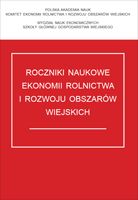Main Article Content
Article Details
Anton J., Kimura S., Matini R. 2011: Risk management in Agriculture in Canada, OECD Food, Agriculture and Fisheries Working Papers, No. 40, OECD Publishing, p. 87.
Kimura S., Anton J. 2011: Farm Income Stabilization and Risk Management: Some Lessons from AgriStability Program in Canada, EAAE Congress, Change and Uncertainty, Challenges for Agriculture, Food and Natural Resources, August 30 to September 2, ETH Zurich, Switzerland.
Kobzar O.A. 2006: Whole-farm risk management in arable farming: portfolio methods for farm-specific business analysis and planning, PhD thesis, Wageningen, Wageningen University, p. 156.
Majewski E., Guba W., Was A. 2007: Farm income risk assessment for selected farm types in Poland - implications of further policy reforms,[in] A Vibrant Rural Economy - The Challenge for Balance S. O'Reilly, M. Keane, P. Enright (ed.), Proceedings of 16th International Farm Management Association Congress., Cork, 15-20 Jul. 2007, New Zealand.
Managing Risk in Agriculture: Policy Assessment and Design. 2011: OECD Publishing, p. 254.
Model calculations - Agricultural Institute of Slovenia. 2013: AIS, http://www.kis.si/pls/kis/!kis.web?m=177&j=SI.
Rednak M. 2012: Economic effect of different agricultural policy measures at farm level, [in] Estimation of Slovene agriculture development possibilities until 2020, S. Kavčič (ed.), Project report, University of Ljubljana, 110 p. (in Slovene), not published.
Severini S. and Cortignani R. 2011: Modeling farmer participation to a revenue insurance scheme by means of Positive Mathematical Programming, EAAE Congress, Change and Uncertainty, Challenges for Agriculture, Food and Natural Resources, August 30 to September 2, ETH Zurich, Switzerland.
Vrolijk H.C.J., Poppe K.J. 2008: Income volatility and income crises in the European Union. In: Income stabilisation in European agriculture, [in] Design and economic impact of risk management tools. M.P.M. Meuwissen, M.A.P.M. Asseldonk, R.B.M. Huirne (ed.), Wageningen Academic Publishers, The Netherlands, p. 224.
Downloads
- Werner Kleinhanss, DEVELOPMENT OF PRODUCTIVITY OF PIG FARMS IN GERMANY , Annals of Agricultural Economics and Rural Development: Vol. 100 No. 4 (2013)
You may also start an advanced similarity search for this article.




